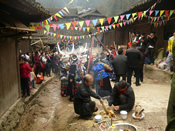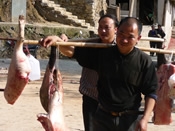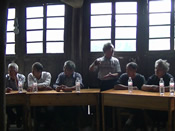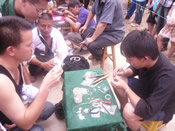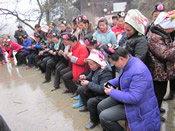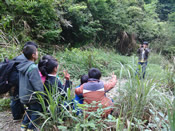By Chang Zhuqing, Programme Officer (Cultural Reflection in Guizhou), PCD

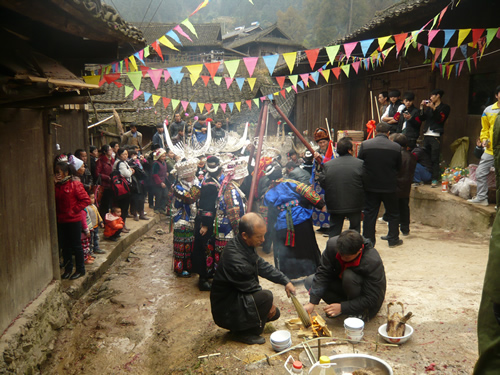 |
| Chiguzang is a sacrificial ritual to give offerings to the souls of ancestors and to pray for ancestors' blessings and protection so that their descendants may live in peace and prosperity. |
Crisis of the village of silversmiths
Kongbai Village in Guizhou's Leishan County is a typical Miao village. There are ancient legends, beautiful natural scenery, traditional stilt houses (Putonghua as diaojiaolou [literally "hanging feet loft": storeyed buildings supported by stilts]) and unique festivals and customs. Kongbai is best known, however, for is its tradition of silver ornamentation. The most celebrated Miao silversmiths all gather in Kongbai, the most famous silversmith village. Kongbai had its moments of glory in history. It produced most of the silver ornaments and silverware in regions inhabited by the Miao. Designing and crafting silver ornaments was historically the main source of livelihood for Kongbai villagers.
In recent years, many silversmiths have left the village to study or seek work in the cities. The younger people who have done so not only lose touch with their rich village culture but also find it difficult to integrate into the unfamiliar urban setting and lifestyle. Without spiritual sustenance they gradually become marginalised in the cities. In the meantime the silversmith village also declines because only elderly people and children remain. Over 200 mu of arable land lies idle at Kongbai and few people take part in collective cultural activities. The village is becoming an ailing 'hollow village' that has lost its vigour and cultural self-confidence. The income of village silversmiths has also declined.
The reflection and quest of a community
Since 2009, PCD and the School of Geographic and Environmental Sciences of Guizhou Normal University have been collaborating in a programme on collective memory and community documentation to help Kongbai villagers explore their community culture and regain their cultural self-confidence. Activities have been launched for villagers to experience and to document the culture of the community. Exchanges between communities from different ethnic groups and from different regions, as well as internal exchange activities within the community, have been organised. As they experience and learn about the culture of their village, the villagers naturally reflect on the problems facing their community and on its future development. They have reached a determination to inherit and to pass on their culture and collective memory. A programme, 'Kongbai's Guzang Culture as Cultural and Spiritual Bond', has been launched to restore their cultural self-confidence and a proactive attitude to help villagers face future changes.
The activity to document chiguzang [1] , the traditional ceremony to give offerings to the ancestors, has had a profound impact on Kongbai villagers, particularly young and middle-aged men. They were initially interested only in financial income. After participating in the programme, they became concerned with the development of their community, the social relationships within it and the absence of spiritual values. The young people feel that the guzang culture [2] is weakening in terms of its authority and influence. Young people are uninterested in the cultural significance of traditional sacrificial ceremonies and the general feeling about chiguzang as a sacred ceremony has also declined, reducing it to the status of a village-level recreational activity. Villagers who have returned from the cities do not feel that they belong to the village anymore and children who are growing up in an urban environment do not even want to stay in the village. This has given rise to all sorts of cultural conflicts.
After discussion the villagers came to the conclusion that reviving the guzang culture, which is fast disappearing, is critical to the future development of the village.
The unique culture of chiguzang
Miao people have migrated many times. Since they do not have a written language, they have been using costumes, songs, festivals and rituals to pass on their culture. Chiguzang is the most important sacrificial ceremony for the Miao people, embodying the core values and spirit of Miao culture.
Kongbai historically consisted of nine villages. During the Qing Dynasty, the Miao people of Kongbai rose up against oppression from the Qing army. But the uprising was crushed and the Kongbai people were forced to leave their homes. Now their descendants are scattered in a dozen villages in Leishan and Kaili. The ritual of chiquzang is carried out once every 13 years [3]. It is a vehicle that helps the Kongbai diaspora to keep their collective memory alive.
Chiguzang is organised by the master of guzang (the sacrificial priest) and the whole community takes part. The ceremony is truly an embodiment of the spiritual and cultural bonds of the community and an important component of the cultural identity of the Miao people. During the period of chiguzang, no matter how far away from home is a Kongbai villager, he or she will return home to be present. Their relatives and friends, and villagers from neighbouring settlements also come to witness the grand and solemn ceremony. It is the highest manifestation of the cultural heritage of the Miao. By honouring their ancestors through the activities of chiguzang, a stable kinship system is formed and a public and cultural ethos of solidarity and mutual help is built, encouraging villagers to contribute to the public affairs of the community. The activities also strengthen the exchange between individuals, alleviating isolation and tension. The prosperity and development of Kongbai therefore lies in such a collective memory of this communal tradition.
To revive the collective memory of chiguzang among the villagers, PCD and the university programme team have been facilitating activities for villagers to recall their memories of chiguzang in the old days and for them to experience and compare the changes in the culture of guzang by visiting diaspora communities[4]. In this way, villagers become aware of the changes and the absence of the guzang culture in Kongbai, and re-experience the value of the guzang culture to the community. Through subsequent sharing activities in Kongbai, villagers who took part in exchange activities with the diaspora communities shared what they had learnt with other villagers, thus arousing their concern and reflection. Thanks to this process, a shared identity has been built between Kongbai villagers and the diaspora communities,which have been reconnected and a larger Kongbai community network has been formed.
Sense of spiritual belonging of Kongbai villagers
When chiguzang becomes a public issue in Kongbai, the collective memory of the culture of guzang is awakened among villagers and a strong sense of cultural belonging in the community begins to grow. Villagers become aware of the importance and meaning of solidarity, mutual help and sacrifice. to the development of the community. They are roused to pursue and act for sustainable living, and are willing to settle internal civil disputes by traditional mechanisms such as adjudication by the master of guzang and through dapinghuo [5]. The master of guzang is also proud that he can still contribute to the well-being of his community . The Society of the Elderly, whose representative is the guzang master, has come up with many ways to attract young people to return to their community. Because of the influence of the guzang master, the elderly people, the village committee and the Society of Silversmiths, Kongbai's silversmiths always return home for festivals no matter how busy they are.
Villagers of Kongbai have resolved to cherish their cultural inheritance and to pass it on to the next generation. Li Zhengyun, holding the title of Master of Craft, offers free craft training to young silversmiths in the hope of improving the silversmiths' livelihood. Women take part actively in embroidery training [6] while female singing masters organise Miao song competitions. By such actions, Kongbai villagers are sending historical and cultural messages to the younger generation.
Long Taiyang, a young silversmith who has developed pride and self-confidence in Miao culture, liaised with the committees of four neighbouring villages to hold cultural activities together, to elicit the collective memory of the Miao so that all communities in the region may reach a consensus on strengthening their heritage, and face the ever-changing external influences with cultural resilience. Subsequently, a week-long event entitled 'Chixinjie: An Appointment with Miao Culture' [7] was organised. The Miao culture of Kongbai and four neighbouring communities was celebrated and contests were held in silver ornament making, embroidery, Miao singing and dancing, cock fighting and bullfighting. Young people attending the event became interested in learning Miao culture, creating a positive attitude to cultural heritage in the community.
The guzang culture that is an embodiment of the collective memory of the Miao people has awakened Kongbai villagers' quest for a good life. Even though they may still lead a difficult life, making a living by producing silver ornaments, they are now proud of their Kongbai identity. No matter what challenges and crises their community is confronted with, its collective memory, embodied by chiguzang, will help Kongbai villagers face an uncertain future.
- Chiguzang is a Miao term. It is a ceremony that a kin group carries out to give offerings to their common ancestors.
- Guzang culture is a culture of the Miao people on giving offerings to their ancestors. The culture is composed of many elements and details such as the origin of chiguzang, the souls of ancestors, the community organisation that runs the ceremony, the masters of guzang who lead it, the venue and the date to give the offerings, taboos during the period of the chiguzang, etc.
- The ancestors of Kongbai were forced to leave their homes after a failed uprising against the Qing Dynasty. Some Miao people returned to Kongbai after a number of years. After returning and also working hard for 12 years, they got a bumper harvest. To celebrate and commemorate their ancestors, they held a ceremony to give offerings to them. Hence, chiguzang is held only once in 13 years. As the year for holding chiguzang draws near, sacrificial rituals become more elaborate.
-
Most of the ancestors of the Miao diaspora communities came from Kongbai. In the tales of Kongbai and in historical literature on the Qing Dynasty, the Miao people rose up against the dynasty in 1735 but the uprising was crushed. Villagers of Kongbai escaped and were scattered in communities far from home. The present Kongbai villagers are mainly descendants of those who escaped and later returned to Kongbai in 1874.
-
Miao people have recorded the history of their diaspora on their costumes. The Miao people pass on their stories to their descendants through embroidery. It is also a form of expression of love between mothers and daughters. Because of this programme, women of Kongbai learnt about the meaning of their costumes, and use activities on Miao embroidery to pass on this culture.
-
On the day of the festival of chixinjie, every family picks some young rice shoots which they offer to their ancestors together with rice wine and fish. They then pray to the King of Grains not to inflict any disaster on them, whether it be pests, wind, sickness or wild animals. In other words, it is a festival to celebrate a bumper harvest in advance and to give offerings to ancestors.



